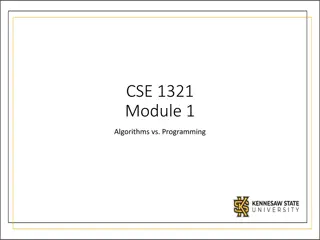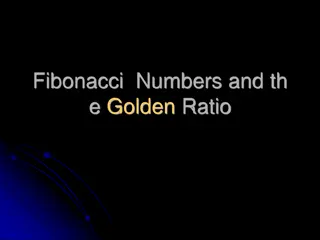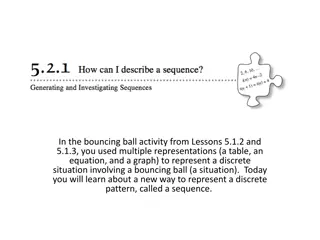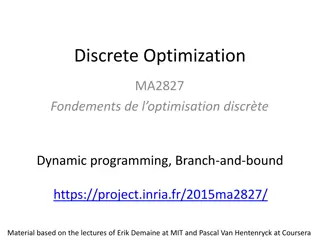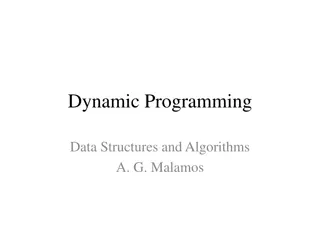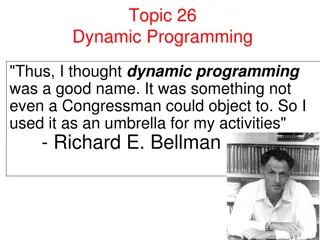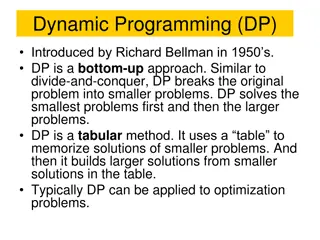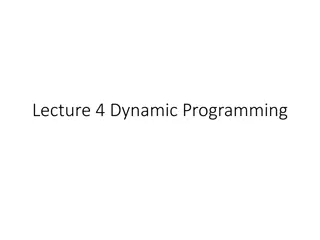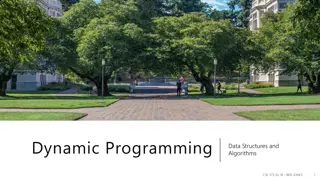Dynamic Programming in Algorithms: Fibonacci Sequence and Efficiency
Covering dynamic programming concepts and algorithms, this content explores the Fibonacci sequence as a warm-up example, discussing the efficient computation of Fibonacci numbers. It delves into dynamic programming principles, such as breaking down problems into smaller subproblems and using memorization. The inefficient recursive algorithm for Fibonacci is contrasted with more efficient dynamic programming approaches, showcasing how to compute Fibonacci numbers in O(n) time complexity and even more efficiently in O(log(n)). Examples, runtime analyses, and a plan for the week's topics in algorithm design are included.
Download Presentation

Please find below an Image/Link to download the presentation.
The content on the website is provided AS IS for your information and personal use only. It may not be sold, licensed, or shared on other websites without obtaining consent from the author.If you encounter any issues during the download, it is possible that the publisher has removed the file from their server.
You are allowed to download the files provided on this website for personal or commercial use, subject to the condition that they are used lawfully. All files are the property of their respective owners.
The content on the website is provided AS IS for your information and personal use only. It may not be sold, licensed, or shared on other websites without obtaining consent from the author.
E N D
Presentation Transcript
CMPT 405/705 Design & Analysis of Algorithms February 28, 2022
Plan for this week Dynamic programming Fibonacci sequence (a warmup example) Edit distance/Sequence alignment The knapsack problem Finding Hamiltonian path in time O(2n) Finding a path of length k in time exp(k) Color coding
Dynamic Programming (DP)
Dynamic Programming A general paradigm that in which a problem is solved by breaking it into smaller subproblems tackling them one by one, smallest first using the answers to small subproblems solve the larger problem Similar to the divide-and-conquer paradigm using recursion. However, instead of recursive calls we use memorization.
Simple Example: Fibonacci sequence
Fibonacci sequence Fibonacci sequence: Fib(0) = 0, Fib(1) = 1 Fib(n) = Fib(n-1) + Fib(n-2) for all n>1. That is, the sequence is: 0, 1, 1, 2, 3, 5, 8, 13, 21, 34, 55, 89, 144 Write an algorithm that gets an integer n>=0 and outputs Fib(n).
Fibonacci sequence very inefficient Input: A positive integer n What is the runtime of the algorithm? Output: Fib(n) Recursive algorithm: Denote by T(n) the runtime of Fib(n) Then T(n) = T(n-1) + T(n-2) + O(1) > 2*T(n-2) + O(1) 1. If n <= 1 return n 2. Otherwise T(n) > 2*T(n-2) > 4*T(n-4) > 8*T(n-6) Let x = Fib(n-1) Let y = Fib(n-2) T(n) > 2n/2=1.4n return x+y
Fibonacci sequence more efficient Input: A positive integer n Output: Fib(n) What is the runtime of the algorithm? A dynamic programming approach : T(n) = O(n) 1. Create an array A[0 n] Actually, it s O(n2) bit operations because each number is (n) digits long 2. Set A[0] = 0 3. Set A[1] = 1 We used memorization to avoid repeated recursive calls 4. For i=2 n A[i] = A[i-1] + A[i-2] 1. Return A[n]
Fibonacci sequence even more efficient Input: A positive integer n Goal: Compute Fib(n) in O(log(n)) operations. Fib(n) uses (n) digits, which would imply O(n log(n)) time. But if we don t want to worry about bit representation, we can slightly change the goal: Input: A positive integer n, and a prime p (say p=7) Goal: Compute Fib(n) mod p in O(log(n)) time.
Fibonacci sequence even more efficient Input: A positive integer n, and a prime p (say p=7) Goal: Compute Fib(n) mod p in O(log(n)) time. 0 1 Idea: Use some more linear algebra: A = 1 1 Fn Fn+1 0 1 Fn-1 Fn = 1 1
Fibonacci sequence even more efficient F1=1 F2=1 0 1 0 = 1 1 1 F2=1 F3=2 F1=1 F2=1 0 1 0 1 0 0 1 = = * * * 1 1 1 1 1 1 1 0 1 0 F3=2 F4=3 0 1 0 1 = * * * 1 1 1 1 1 1 1
Fibonacci sequence even more efficient Input: A positive integer n, and a prime p (say p=7) Goal: Compute Fib(n) mod p in O(log(n)) time. Q: How to compute An (mod p) in time O(log n)? Algorithm: 0 1 Let A = 1 1 A: Compute - A2 = A * A - A4 = A2 * A2 - A8 = A4 * A4 - Use these to compute An (hint: look at the binary expansion of n) Fn Fn+1 0 Then = An 1 For example: A13 = A8 * A4 * A
Fibonacci sequence closed formula Fn Fn+1 0 Then 0 1 = An Let A = 1 1 1 ? ? + ? ? + ? ? ? ? ? SVD: A = ? ? ? ? ? + ? ? + ? ? ? ? ? ? ? ? 0 ? ? ? An = (UDU-1)*(UDU-1)* *(UDU-1) = U * Dn *U-1 A = UDU-1 ? ? ? + ? ? + ? ? ? ? ? An = ? ? ? ? ? ? + ? ? ? ? ? + ? ? ? ? ? 0 ? ? ?
Fibonacci sequence closed formula ?? ??+? 0 = An 1 ? ? ? + ? ? + ? ? ? ? ? 0 ? ? ? = ? ? ? + ? ? ? ? ? ? + ? ? ? ? 1 0 ? ? ? ? ? ? + ? ? ? ? ? ? = ? ? ? + ? ? ? ? ? ? ? ? 0 ? ? ? ? ? ? + ? ? ? ? + ? ? ? ? ? ? ? ? ? ? ? ? = = ? ? ? ? ? + ? ? ? ? ? ? ??+?
Fibonacci sequence even more efficient Comments: The recursive formula doesn t work mod p Because the eigenvalues don t work mod p
Edit distance / Sequence alignment
Edit distance Input: Two strings X and Y Goal: find smallest number of edit operations required to convert X into Y. X = G T A G C G G C G Y = G T A A C G G C G Mismatch Gap in X / Insertion in Y X = G T A G C G C G Y = G T A G C T G C G Gap in Y / Insertion in X X = G T A G C G C G Y = G T G C G C G
Edit distance Input: Two strings X and Y Goal: find smallest number of edit operations required to convert X into Y. Example: X = G C G T A T G A G G C T A A C G C Y = G C T A T G C G G C T A T A C G C X = G C G T A T G A G G C T A A C G C Y = G C T A T G C G G C T A T A C G C Optimal alignment Edit Distance = 3
Hamming distance A related (simpler) notion: Two strings X and Y of the same length Goal: smallest number of mismatches between X to Y. X = G T A C G G C G G A C A Y = G T A A C G G C G G A T Examples: X = G T A G C G G C G G A C Y = G T A A C G G C G G A T HamDist(X,Y) = 2 X = S T R O N G E R Y = S T R E N G T H HamDist(X,Y) = 3 Design a linear time algorithm that given two strings X,Y of length n, computes the hamming distance between X and Y.
Edit distance vs Hamming distance Claim: For two strings X, Y of equal length EditDist(X, Y) <= HammingDist(X, Y) Proof: For edit distance we can use substitution only. What about the other direction? Is there any non-trivial relation? Example: X = ababababababababab Y = bababababababababa Q1: What is the edit distance between X and Y? A1: EditDist(X,Y) = 2 : remove a from the beginning of X and add a to the end. Q2: What is the HammingDist(X, Y)? A2: HammingDist(X, Y) = n
Edit distance Input: Two strings X and Y Goal: find smallest number of edit operations required to convert X into Y. Allowed operations: X = G C G T A T G A G G C T A A C G C Y = G C T A T G C G G C T A T A C G C R replace I insert into X X = G C G T A T G A G G C T A A C G C Y = G C T A T G C G G C T A T A C G C D delete from X Edit Distance = 3
Edit distance Idea: input X of length n, and Y of length m 1. Let OPT(i,j) = min cost of aligning prefix strings X[1 i] and Y[1 j]. 2. Then, the goal is to compute OPT(n,m) 3. Suppose that (by recursion) we can solve the shorter subproblems. 4. We want to compute OPT(i,j): we have 4 options 4.1 If X[i] = Y[j] : use the optimal alignment for X[1 i-1] and Y[1 j-1] 4.2 Try replacing X[i] with Y[j] 4.3 Try deleting X[i] from X 4.4 Try appending Y[j] to X[1 i] 5. Choose the best of the four options
Edit distance Input: Two strings: X of length n and Y of length m Goal: Find an optimal alignment of X and Y, i.e., smallest number of edit operations required to convert X into Y. Algorithm: 1. Define a matrix D[0 n,0 .m], so that D[i,j] = EditDist( X[1 i] , Y[1 j] ) 2. Set D[i,0] = i for all i=0 n Here: 1X[i] Y[j] = 1 if X[i] Y[j] 1X[i] Y[j] = 0 if X[i] = Y[j] 3. Set D[0,j] = j for all j=0 m 4. For i>0,j>0 define D[i,j] = min (D[ i-1 , j ] + 1 (D[ i-1 , j-1 ] + 1X[i] Y[j] (D[ i, j-1 ] + 1 // Insert Y[j] after X[i] // Delete X[i] from X // Match or Mismatch
Edit distance Example: X = BLOCK Y = BOOK: A solution: (1) remove L and (2) replace C with O. D[i,j] = min (D[ i-1 , j ] + 1 (D[ i-1, j-1 ] + 1X[i] Y[j] (D[ i , j-1 ] + 1 // Insert Y[j] after X[i] // Delete X[i] from X // Match or Mismatch
Edit distance Example: X = BLOCK Y = BOOK: A solution: (1) remove L and (2) replace C with O. D[i,j] = min (D[ i-1 , j ] + 1 (D[ i-1, j-1 ] + 1X[i] Y[j] (D[ i , j-1 ] + 1 // Insert Y[j] after X[i] // Delete X[i] from X // Match or Mismatch
Edit distance Example: X = BLOCK Y = BOOK: A solution: (1) replace L with O and (2) remove C. D[i,j] = min (D[ i-1 , j ] + 1 (D[ i-1, j-1 ] + 1X[i] Y[j] (D[ i , j-1 ] + 1 // Insert Y[j] after X[i] // Delete X[i] from X // Match or Mismatch
Edit distance with costs Algorithm: 1. Define a matrix D[0 n,0 .m], so that D[i,j] = min-cost( X[1 i] , Y[1 j] ) 2. Set D[i,0] = i* for all i=0 n 3. Set D[0,j] = j* for all j=0 m 4. For i>0,j>0 define D[i,j] = min (D[ i-1 , j ] + (D[ i-1 , j-1 ] + X[i], Y[j] (D[ I , j-1 ] + // Insert Y[j] after X[i] // Delete X[i] from X // Match or Mismatch Q: What is the running time? A: The table is of size m*n, and computing each entry takes O(1) operations.\ Therefore, the running time is O(nm)
Edit distance with costs Theorem: There is an algorithm that given strings X and Y on inputs of length n, computes the edit distance is time O(n2) Q: Can we design a faster algorithm? A: Theorem. [Backurs Indyk 2015] If can compute edit distance of two strings of length n in O(n1.99) time, then we can solve SAT with n variables and m clauses in poly(m) 2(1 )n time for some constant > 0 I will talk about SAT next week. But the points is: if we can solve Edit Distance faster, then we can solve some other problems faster than we expect possible
The Shortest Path Bellman-Ford Algorithm
The shortest path problem Input: G= (V,E) with distances {c(e)>0 : e E} on edges, and two vertices s,t V. Output: Shortest path from s to t. Denote by dist(s,v,i) the shortest path from s to v that uses at most i edges. Observation1: One of the two cases always holds: 1. Either dist(s,v,i) =dist(s,v,i-1) 2. Or dist(s,v,i) = min(u,v) E { dist(s,u,i-1) + c(u,v) } u s t v Observation2: the shortest path uses at most n-1 edges, where n=|V|
The shortest path problem Input: G= (V,E) with distances {c(e)>0 : e E} on edges, and two vertices s,t V. Output: Shortest path from s to t. Correctness is usually done by induction on the distance between s and t. Algorithm: 1. Create a matrix dist of dimensions V x n // dist(v,i) = the shortest path from s to v that uses at most i edges. 2. Set dist(s,0) = 0 and dist(v,0) = for all v V\ {s} 3. For i=1 n But let s skip the proof of correctness For each v V Return dist(t,n-1) Set d1 = min (u,v) E { dist(u,i-1) + c(u,v) } Set d2 = dist(v,i-1) Set dist(v,i) = min(d1, d2) 4.
The shortest path problem Input: G= (V,E) with distances {c(e)>0 : e E} on edges, and two vertices s,t V. Output: Shortest path from s to t. What is the runtime of the algorithm? Algorithm: 1. Create a matrix dist of dimensions V x n // dist(s,i) = the shortest path from s to v that uses at most i edges. 2. Set dist(s,0) = 0 and dist(v,0) = for all v V\ {s} n*n iterations Deg(v) steps in each iteration 3. For i=1 n For each v V Return dist(t,n-1) Set d1 = min u:(u,v) E { dist(u,i-1) + c(u,v) } Set d2 = dist(v,i-1) Set dist(v,i) = min(d1, d2) Total runtime is O(n3) 4.
Questions? Comments?


